Data consists of observations across different types of variables, and it is vital that any Data Analyst understands these intricacies at the earliest stage of exposure to statistical analysis. This chapter recognizes the importance of data and begins with a template of a dummy questionnaire and then proceeds with the nitty-gritties of the subject. We then explain how uncertainty creeps in to the domain of computer science. The chapter closes with coverage of important families of discrete and continuous random variables.
We will cover the following topics:
Identification of the main variable types as nominal, categorical, and continuous variables
The uncertainty arising in many real experiments
R installation and packages
The mathematical form of discrete and continuous random variables and their applications
The goal of this section is introduction of numerous variable types at the first possible occasion. Traditionally, an introductory course begins with the elements of probability theory and then builds up the requisites leading to random variables. This convention is dropped in this book and we begin straightaway with data. There is a primary reason for choosing this path. The approach builds on what the reader is already familiar with and then connects it with the essential framework of the subject.
It is very likely that the user is familiar with questionnaires. A questionnaire may be asked after the birth of a baby with a view to aid the hospital in the study about the experience of the mother, the health status of the baby, and the concerns of immediate guardians of the new born. A multi-store department may instantly request the customer to fill in a short questionnaire for capturing the customer's satisfaction after the sale of a product. A customer's satisfaction following the service of their vehicle (see the detailed example discussed later) can be captured through a few queries. The questionnaires may arise in different forms than just merely on paper. They may be sent via e-mail, telephone, short message service (SMS), and so on. As an example, one may receive an SMS that seeks a mandatory response in a Yes/No form. An e-mail may arrive in the Outlook inbox, which requires the recipient to respond through a vote for any of these three options, "Will attend the meeting", "Can't attend the meeting", or "Not yet decided".
Suppose the owner of a multi-brand car center wants to find out the satisfaction percentage of his customers. Customers bring their car to a service center for varied reasons. The owner wants to find out the satisfaction levels post the servicing of the cars and find the areas where improvement will lead to higher satisfaction among the customers. It is well known that the higher the satisfaction levels, the greater would be the customer's loyalty towards the service center. Towards this, a questionnaire is designed and then data is collected from the customers. A snippet of the questionnaire is given in figure 1, and the information given by the customers lead to different types of data characteristics. The variables Customer ID and Questionnaire ID may be serial numbers or randomly generated unique numbers. The purpose of such variables is unique identification of people's response. It may be possible that there are follow-up questionnaires as well. In such cases, the Customer ID for a responder will continue to be the same, whereas the Questionnaire ID needs to change for identification of the follow up. The values of these types of variables in general are not useful for analytical purpose.
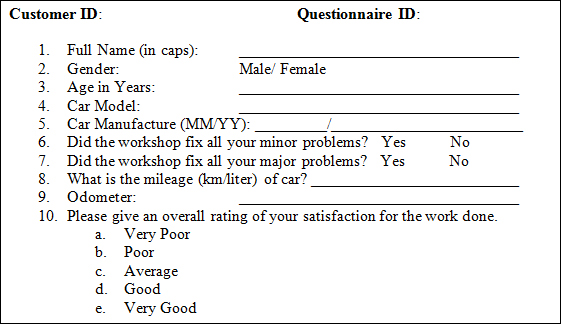
Figure 1: A hypothetical questionnaire
The information of Full Name in this survey is a starting point to break the ice with the responder. In very exceptional cases the name may be useful for profiling purposes. For our purposes the name will simply be a text variable that is not used for analysis purposes. Gender is asked to know the person's gender, and in quite a few cases it may be an important factor explaining the main characteristics of the survey, in this case it may be mileage. Gender is an example of a categorical variable.
Age in Years is a variable that captures the age of the customer. The data for this field is numeric in nature and is an example of a continuous variable.
The fourth and fifth questions help the multi-brand dealer in identifying the car model and its age. The first question here enquires about the type of the car model. The car models of the customers may vary from Volkswagen Beetle, Ford Endeavor, Toyota Corolla, Honda Civic, to Tata Nano, see the next screenshot. Though the model name is actually a noun, we make a distinction from the first question of the questionnaire in the sense that the former is a text variable while the latter leads to a categorical variable. Next, the car model may easily be identified to classify the car into one of the car categories, such as a hatchback, sedan, station wagon, or utility vehicle, and such a classifying variable may serve as one of the ordinal variable, as per the overall car size. The age of the car in months since its manufacture date may explain the mileage and odometer reading.
The sixth and seventh questions simply ask the customer if their minor/major problems were completely fixed or not. This is a binary question that takes either of the values, Yes or No. Small dents, power windows malfunctioning, niggling noises in the cabin, music speakers low output, and other similar issues, which do not lead to good functioning of the car may be treated as minor problems that are expected to be fixed in the car. Disc brake problems, wheel alignment, steering rattling issues, and similar problems that expose the user and co-users of the road to danger are of grave concern, as they affect the functioning of a car and are treated as major problems. Any user will expect all of his/her issues to be resolved during a car service. An important goal of the survey is to find the service center efficiency in handling the minor and major issues of the car. The labels Yes/No may be replaced by +1 and -1, or any other label of convenience.
The eighth question, "What is the mileage (km/liter) of car?", gives a measure of the average petrol/diesel consumption. In many practical cases this data is provided by the belief of the customer who may simply declare it between 5 km/liter to 25 km/liter. In the case of a lower mileage, the customer may ask for a finer tune up of the engine, wheel alignment, and so on. A general belief is that if the mileage is closer to the assured mileage as marketed by the company, or some authority such as Automotive Research Association of India (ARAI), the customer is more likely to be happy. An important variable is the overall kilometers done by the car up to the point of service. Vehicles have certain maintenances at the intervals of 5,000 km, 10,000 km, 20,000 km, 50,000 km, and 100,000 km. This variable may also be related with the age of the vehicle.
Let us now look at the final question of the snippet. Here, the customer is asked to rate his overall experience of the car service. A response from the customer may be sought immediately after a small test ride post the car service, or it may be through a questionnaire sent to the customer's e-mail ID. A rating of Very Poor suggests that the workshop has served the customer miserably, whereas the rating of Very Good conveys that the customer is completely satisfied with the workshop service. Note that there is some order in the response of the customer, in that we can grade the ranking in a certain order of Very Poor < Poor < Average < Good < Very Good. This implies that the structure of the ratings must be respected when we analyze the data of such a study. In the next section, these concepts are elaborated through a hypothetical dataset.
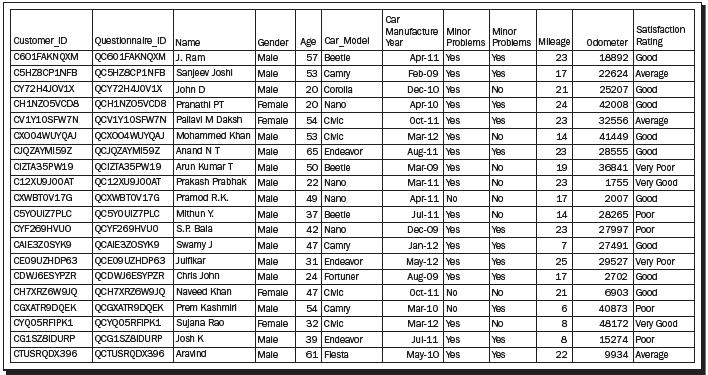
A hypothetical dataset of a Questionnaire
A snippet of an R session is given in Figure 2. Here we simply relate an R session with the survey and sample data of the previous table. The simple goal here is to get a feel/buy-in of R and not necessarily follow the R codes. The R installation process is explained in the R installation section. Here the user is loading the SQ R data object (SQ simply stands for sample questionnaire) in the session. The nature of the SQ object is a data.frame that stores a variety of other objects in itself. For more technical details of the data.frame function, see The data.frame object section of Chapter 2, Import/Export Data. The names of a data.frame object may be extracted using the function variable.names. The R function class helps to identify the nature of the R object. As we have a list of variables, it is useful to find all of them using the function sapply. In the following screenshot, the mentioned steps have been carried out:

Figure 2: Understanding the variable types of an R object
The variable characteristics are also on expected lines, as they truly should be, and we see that the variables Customer_ID, Questionnaire_ID, and Name are character variables; Gender, Car_Model, Minor_Problems, and Major_Problems are factor variables; DoB and Car_Manufacture_Year are date variables; Mileage and Odometer are integer variables; and finally the variable Satisfaction_Rating is an ordered and factor variable.
In the remainder of this chapter we will delve into more details about the nature of various data types. In a more formal language a variable is called a random variable, abbreviated as RV in the rest of the book, in statistical literature. A distinction needs to be made here. In this book we do not focus on the important aspects of probability theory. It is assumed that the reader is familiar with probability, say at the level of Freund (2003) or Ross (2001). An RV is a function that maps from the probability (sample) space  to the real line. From the previous example we have
to the real line. From the previous example we have Odometer and Satisfaction_Rating as two examples of a random variable. In a formal language, the random variables are generally denoted by letters X, Y, …. The distinction that is required here is that in the applications what we observe are the realizations/values of the random variables. In general, the realized values are denoted by the lower cases x, y, …. Let us clarify this at more length.
Suppose that we denote the random variable Satisfaction_Rating by X. Here, the sample space  consists of the elements Very Poor, Poor, Average, Good, and Very Good. For the sake of convenience we will denote these elements by O1, O2, O3, O4, and O5 respectively. The random variable X takes one of the values O1,…, O5 with respective probabilities p1,…, p5. If the probabilities were known, we don't have to worry about statistical analysis. In simple terms, if we know the probabilities of the
consists of the elements Very Poor, Poor, Average, Good, and Very Good. For the sake of convenience we will denote these elements by O1, O2, O3, O4, and O5 respectively. The random variable X takes one of the values O1,…, O5 with respective probabilities p1,…, p5. If the probabilities were known, we don't have to worry about statistical analysis. In simple terms, if we know the probabilities of the Satisfaction_Rating RV, we can simply use it to conclude whether more customers give Very Good rating against Poor. However, our survey data does not contain every customer who have availed car service from the workshop, and as such we have representative probabilities and not actual probabilities. Now, we have seen 20 observations in the R session, and corresponding to each row we had some values under the Satisfaction_Rating column. Let us denote the satisfaction rating for the 20 observations by the symbols X1,…, X20. Before we collect the data, the random variables X1,…, X20 can assume any of the values in  . Post the data collection, we see that the first customer has given the rating as Good (that is, O4), the second as Average (O3), and so on up to the twentieth customer's rating as Average (again O3). By convention, what is observed in the data sheet is actually X1,…, x20, the realized values of the RVs X1,…, X20.
. Post the data collection, we see that the first customer has given the rating as Good (that is, O4), the second as Average (O3), and so on up to the twentieth customer's rating as Average (again O3). By convention, what is observed in the data sheet is actually X1,…, x20, the realized values of the RVs X1,…, X20.
The common man of the previous century was skeptical about chance/randomness and attributed it to the lack of accurate instruments, and that information is not necessarily captured in many variables. The skepticism about the need for modeling for randomness in the current era continues for the common man, as he feels that the instruments are too accurate and that multi-variable information eliminates uncertainty. However, this is not the fact, and we will look here at some examples that drive home this point. In the previous section we dealt with data arising from a questionnaire regarding the service level at a car dealer. It is natural to accept that different individuals respond in distinct ways, and further the car being a complex assembly of different components responds differently in near identical conditions. A question then arises whether we may have to really deal with such situations in computer science, which involve uncertainty. The answer is certainly affirmative and we will consider some examples in the context of computer science and engineering.
Suppose that the task is installation of software, say R itself. At a new lab there has been an arrangement of 10 new desktops that have the same configuration. That is, the RAM, memory, the processor, operating system, and so on are all same in the 10 different machines. For simplicity, assume that the electricity supply and lab temperature are identical for all the machines. Do you expect that the complete R installation, as per the directions specified in the next section, will be the same in milliseconds for all the 10 installations? The run time of an operation can be easily recorded, may be using other software if not manually. The answer is a clear "No" as there will be minor variations of the processes active in the different desktops. Thus, we have our first experiment in the domain of computer science which involves uncertainty.
Suppose that the lab is now two years old. As an administrator do you expect all the 10 machines to be working in the same identical conditions, as we started with identical configuration and environment? The question is relevant as according to general experience a few machines may have broken down. Despite warranty and assurance by the desktop company, the number of machines that may have broken down will not be exactly as assured. Thus, we again have uncertainty.
Assume that three machines are not functioning at the end of two years. As an administrator, you have called the service vendor to fix the problem. For the sake of simplicity, we assume that the nature of failure of the three machines is the same, say motherboard failure on the three failed machines. Is it practical that the vendor would fix the three machines within identical time? Again, by experience we know that this is very unlikely. If the reader thinks otherwise, assume that 100 identical machines were running for two years and 30 of them are now having the motherboard issue. It is now clear that some machines may require a component replacement while others would start functioning following a repair/fix.
Let us now summarize the preceding experiments through the set of following questions:
What is the average installation time for the R software on identically configured computer machines?
How many machines are likely to break down after a period of one year, two years, and three years?
If a failed machine has issues related to motherboard, what is the average service time?
What is the fraction of failed machines that have failed motherboard component?
The answers to these types of questions form the main objective of the Statistics subject. However, there are certain characteristics of uncertainty that are very richly covered by the families of probability distributions. According to the underlying problem, we have discrete or continuous RVs. The important and widely useful probability distributions form the content of the rest of the chapter. We will begin with the useful discrete distributions.
The official website of R is the Comprehensive R Archive Network (CRAN) at www.cran.r-project.org. As of writing of this book, the most recent version of R is 2.15.1. This software can be downloaded for the three platforms Linux, Mac OS X, and Windows.

Figure 3: The CRAN website (a snapshot)
A Linux user may simply key in sudo apt-get install r-base in the terminal, and post the return of right password and privilege levels, the R software will be installed. After the completion of download and installation, the software can be started by simply keying in R at the terminal.
A Windows user first needs to click on Download R for Windows as shown in the preceding screenshot, and then in the base subdirectory click on install R for the first time. In the new window, click on Download R 3.0.0 for Windows and download the .exe file to a directory of your choice. The completely downloaded R-3.0.0-win.exe file can be installed as any other .exe file. The R software may be invoked either from the Start menu, or from the icon on the desktop.
The CRAN repository hosts 4475 packages as of May 01, 2013. The packages are written and maintained by Statisticians, Engineers, Biologists, and others. The reasons are varied and the resourcefulness is very rich, and it reduces the need of writing exhaustive, new functions and programs from scratch. These additional packages can be obtained from http://www.cran.r-project.org/web/packages/. The user can click on Table of available packages, sorted by name, which directs to a new web package. Let us illustrate the installation of an R package named gdata.
We now wish to install the package gdata. There are multiple ways of completing this task. Clicking on the gdata label leads to the web page http://www.cran.r-project.org/web/packages/gdata/index.html. In this HTML file we can find a lot of information about the package from Version, Depends, Imports, Published, Author, Maintainer, License, System Requirements, Installation, and CRAN checks. Further, the download options may be chosen from Package source, MacOS X binary, and Windows binary depending on whether the user's OS is Unix, MacOS, or Windows respectively. Finally, a package may require other packages as a prerequisite, and it may itself be a prerequisite for other packages. This information is provided in the Reverse dependencies section in the options Reverse depends, Reverse imports, and Reverse suggests.
Suppose that the user is having Windows OS. There are two ways to install the package gdata. Start R as explained earlier. At the console, execute the code install.packages("gdata"). A CRAN mirror window will pop up asking the user to select one of the available mirrors. Select one of the mirrors from the list, you may need to scroll down to locate your favorite mirror, and then click on the Ok button. A default setting is dependencies=TRUE, which will then download and install all other required packages. Unless there are some violations, such as the dependency requirement of the R version being at least 2.13.0 in this case, the packages are successfully installed.
A second way of installing the gdata package is as follows. In the gdata web page click on the link gdata_2.11.0.zip. This action will then attempt to download the package through the File download window. Choose the option Save and specify the path where you wish to download the package. In my case, I have chosen the path C:\Users\author\Downloads. Now go to the R window. In the menu ribbon, we have seven options: File, Edit, View, Misc, Packages, Windows, and Help. Yes, your guess is correct and you would have wisely selected Packages from the menu. Now, select the last option of Packages, the Install Package(s) from local zip files option and direct it to the path where you have downloaded the .zip file. Select the file gdata_2.11.0 and R will do the required remaining part of installing the package. One of the drawbacks of doing this process manually is that if there are dependencies, the user needs to ensure that all such packages have been installed before embarking on this second task of installing the R packages. However, despite the problem, it is quite useful to know this technique, as we may not be connected to Internet all the time and install the packages as it is convenient.
The book uses a lot of datasets from the Web, statistical text books, and so on. The file format of the datasets have been varied and thus to help the reader, we have put all the datasets used in the book in an R package, RSADBE, which is the abbreviation of the book's title. This package will be available from the CRAN website as well as the book's web page. Thus, whenever you are asked to run data(xyz), the datasets xyz will be available either in the RSADBE package or datasets package of R.
The book also uses many of the packages available on CRAN. The following table gives the list of packages and the reader is advised to ensure that these packages are installed before you begin reading the chapter. That is, the reader needs to ensure that, as an example, install.packages(c("qcc","ggplot2")) is run in the R session before proceeding with Chapter 3, Data Visualization.
|
Chapter number |
Packages required |
|---|---|
|
2 |
|
|
3 |
|
|
4 |
|
|
5 |
|
|
6 |
|
|
7 |
|
|
8 |
|
|
9 |
|
|
10 |
|
The previous section highlights the different forms of variables. The variables such as Gender, Car_Model, and Minor_Problems possibly take one of the finite values. These variables are particular cases of the more general class of discrete variables.
It is to be noted that the sample space  of a discrete variable need not be finite. As an example, the number of errors on a page may take values as a set of positive integers, {0, 1, 2, …}. Suppose that a discrete random variable X can take values among
of a discrete variable need not be finite. As an example, the number of errors on a page may take values as a set of positive integers, {0, 1, 2, …}. Suppose that a discrete random variable X can take values among  with respective probabilities
with respective probabilities  , that is,
, that is,  . Then, we require that the probabilities be non-zero and further that their sum be 1:
. Then, we require that the probabilities be non-zero and further that their sum be 1:

where the Greek symbol  represents summation over the index i.
represents summation over the index i.
The function  is called the probability mass function (pmf) of the discrete RV X. We will now consider formal definitions of important families of discrete variables. The engineers may refer to Bury (1999) for a detailed collection of useful statistical distributions in their field. The two most important parameters of a probability distribution are specified by mean and variance of the RV X. In some cases, and important too, these parameters may not exist for the RV. However, we will not focus on such distributions, though we caution the reader that this does not mean that such RVs are irrelevant. Let us define these parameters for the discrete RV. The mean and variance of a discrete RV are respectively calculated as:
is called the probability mass function (pmf) of the discrete RV X. We will now consider formal definitions of important families of discrete variables. The engineers may refer to Bury (1999) for a detailed collection of useful statistical distributions in their field. The two most important parameters of a probability distribution are specified by mean and variance of the RV X. In some cases, and important too, these parameters may not exist for the RV. However, we will not focus on such distributions, though we caution the reader that this does not mean that such RVs are irrelevant. Let us define these parameters for the discrete RV. The mean and variance of a discrete RV are respectively calculated as:

The mean is a measure of central tendency, whereas the variance gives a measure of the spread of the RV.
The variables defined so far are more commonly known as categorical variables. Agresti (2002) defines a categorical variable as a measurement scale consisting of a set of categories.
Let us identify the categories for the variables listed in the previous section. The categories for the variable Gender are Male and Female; whereas the car category variables derived from Car_Model are hatchback, sedan, station wagon, and utility vehicles. The variables Minor_Problems and Major_Problems have common but independent categories Yes and No; and finally the variable Satisfaction_Rating has the categories, as seen earlier, Very Poor, Poor, Average, Good, and Very Good. The variable Car_Model is just labels of the name of car and it is an example of nominal variable.
Finally, the output of the variable Satistifaction_Rating has an implicit order in it, Very Poor < Poor < Average < Good < Very Good. It may be realized that this difference poses subtle challenges in their analysis. These types of variables are called ordinal variables. We will look at another type of categorical variable that has not popped up thus far.
Practically, it is often the case that the output of a continuous variable is put in certain bin for ease of conceptualization. A very popular example is the categorization of the income level or age. In the case of income variables, it has been realized in one of the earlier studies that people are very conservative about revealing their income in precise numbers. For example, the author may be shy to reveal that his monthly income is Rs. 34,892. On the other hand, it has been revealed that these very same people do not have a problem in disclosing their income as belonging to one of such bins: < Rs. 10,000, Rs. 10,000-30,000, Rs. 30,000-50,000, and > Rs. 50,000. Thus, this information may also be coded into labels and then each of the labels may refer to any one value in an interval bin. Hence, such variables are referred as interval variables.
A random variable X is said to be a discrete uniform random variable if it can take any one of the finite M labels with equal probability.
As the discrete uniform random variable X can assume one of the 1, 2, …, M with equal probability, this probability is actually  . As the probability remains same across the labels, the nomenclature "uniform" is justified. It might appear at the outset that this is not a very useful random variable. However, the reader is cautioned that this intuition is not correct. As a simple case, this variable arises in many cases where simple random sampling is needed in action. The pmf of discrete RV is calculated as:
. As the probability remains same across the labels, the nomenclature "uniform" is justified. It might appear at the outset that this is not a very useful random variable. However, the reader is cautioned that this intuition is not correct. As a simple case, this variable arises in many cases where simple random sampling is needed in action. The pmf of discrete RV is calculated as:

A simple plot of the probability distribution of a discrete uniform RV is demonstrated next:
> M = 10
> mylabels=1:M
> prob_labels=rep(1/M,length(mylabels))
> dotchart(prob_labels,labels=mylabels,xlim=c(.08,.12),
+ xlab="Probability")
> title("A Dot Chart for Probability of Discrete Uniform RV")Tip
Downloading the example code
You can download the example code files for all Packt books you have purchased from your account at http://www.packtpub.com. If you purchased this book elsewhere, you can visit http://www.packtpub.com/support and register to have the files e-mailed directly to you.
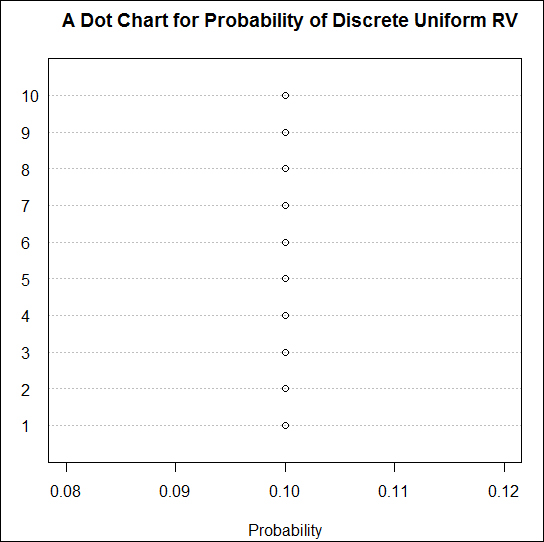
Figure 4: Probability distribution of a discrete uniform random variable
Recall the second question in the Experiments with uncertainty in computer science section, which asks "How many machines are likely to break down after a period of one year, two years, and three years?". When the outcomes involve uncertainty, the more appropriate question that we ask is related to the probability of the number of break downs being x. Consider a fixed time frame, say 2 years. To make the question more generic, we assume that we have n number of machines. Suppose that the probability of a breakdown for a given machine at any given time is p. The goal is to obtain the probability of x machines with breakdown, and implicitly (n-x) functional machines. Now consider a fixed pattern where the first x units have failed and the remaining are functioning properly. All the n machines function independently of other machines. Thus, the probability of observing x machines in the breakdown state is  .
.
Similarly, each of the remaining (n-x) machines have the probability of (1-p) of being in the functional state, and thus the probability of these occurring together is  . Again by the independence axiom value, the probability of x machines with breakdown is then given by
. Again by the independence axiom value, the probability of x machines with breakdown is then given by  . Finally, in the overall setup, the number of possible samples with breakdown (being x and (n-x) samples) being functional is actually the number of possible combinations of choosing x-out-of-n items, which is the combinatorial
. Finally, in the overall setup, the number of possible samples with breakdown (being x and (n-x) samples) being functional is actually the number of possible combinations of choosing x-out-of-n items, which is the combinatorial  . As each of these samples is equally likely to occur, the probability of exactly x broken machines is given by
. As each of these samples is equally likely to occur, the probability of exactly x broken machines is given by  . The RV X obtained in such a context is known as the binomial RV and its pmf is called the binomial distribution. In mathematical terms, the pmf of the binomial RV is calculated as:
. The RV X obtained in such a context is known as the binomial RV and its pmf is called the binomial distribution. In mathematical terms, the pmf of the binomial RV is calculated as:

The pmf of binomial distributions is sometimes denoted by 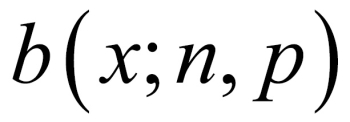 . Let us now look at some important properties of a binomial RV. The mean and variance of a binomial RV X are respectively calculated as:
. Let us now look at some important properties of a binomial RV. The mean and variance of a binomial RV X are respectively calculated as:

Note
As p is always a number between 0 and 1, the variance of a binomial RV is always lesser than its mean.
Example 1.3.1: Suppose n = 10 and p = 0.5. We need to obtain the probabilities p(x), x=0, 1, 2, …, 10. The probabilities can be obtained using the built-in R function dbinom. The function dbinom returns the probabilities of a binomial RV. The first argument of this function may be a scalar or a vector according to the points at which we wish to know the probability. The second argument of the function needs to know the value of n, the size of the binomial distribution. The third argument of this function requires the user to specify the probability of success in p. It is natural to forget the syntax of functions and the R help system becomes very handy here. For any function, you can get details of it using ? followed by the function name. Please do not give a space between CIT and the function name. Here, you can try ?dbinom.
> n <- 10; p <- 0.5 > p_x <- round(dbinom(x=0:10, n, p),4) > plot(x=0:10,p_x,xlab="x", ylab="P(X=x)")
The R function round fixes the accuracy of the argument up to the specified number of digits.
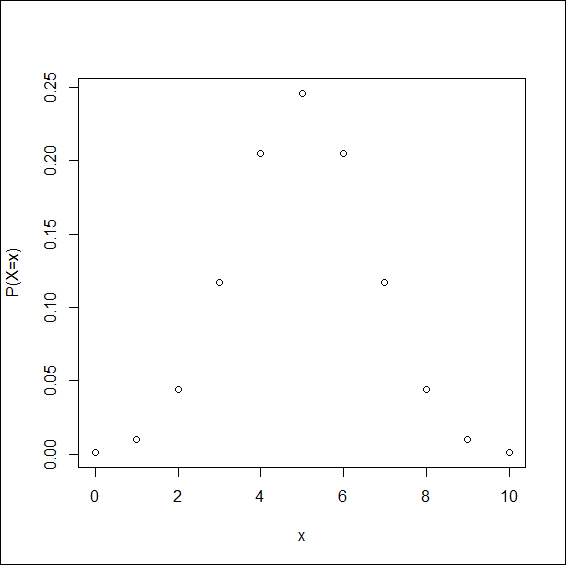
Figure 5: Binomial probabilities
We have used the dbinom function in the previous example. There are three utility facets for the binomial distribution. The three facets are p, q, and r. These three facets respectively help us in computations related to cumulative probabilities, quantiles of the distribution, and simulation of random numbers from the distribution. To use these functions, we simply augment the letters with the distribution name, binom here, as pbinom, qbinom, and rbinom. There will be of course a critical change in the arguments. In fact, there are many distributions for which the quartet of d, p, q, and r are available, check ?Distributions.
Example 1.3.2: Assume that the probability of a key failing on an 83-set keyboard (the authors laptop keyboard has 83 keys) is 0.01. Now, we need to find the probability when at a given time there are 10, 20, and 30 non-functioning keys on this keyboard. Using the dbinom function these probabilities are easy to calculate. Try to do this same problem using a scientific calculator or by writing a simple function in any language that you are comfortable with.
> n <- 83; p <- 0.01 > dbinom(10,n,p) [1] 1.168e-08 > dbinom(20,n,p) [1] 4.343e-22 > dbinom(30,n,p) [1] 2.043e-38 > sum(dbinom(0:83,n,p)) [1] 1
As the probabilities of 10-30 keys failing appear too small, it is natural to believe that may be something is going wrong. As a check, the sum clearly equals 1. Let us have a look at the problem from a different angle. For many x values, the probability p(x) will be approximately zero. We may not be interested in the probability of an exact number of failures, though we are interested in the probability of at least x failures occurring, that is, we are interested in the cumulative probabilities  . The cumulative probabilities for binomial distribution are obtained in R using the
. The cumulative probabilities for binomial distribution are obtained in R using the pbinom function. The main arguments of pbinom include size (for n), prob (for p), and q (the x argument). For the same problem, we now look at the cumulative probabilities for various p values:
> n <- 83; p <- seq(0.05,0.95,0.05)
> x <- seq(0,83,5)
> i <- 1
> plot(x,pbinom(x,n,p[i]),"l",col=1,xlab="x",ylab=
+ expression(P(X<=x)))
> for(i in 2:length(p)) { points(x,pbinom(x,n,p[i]),"l",col=i)}
Figure 6: Cumulative binomial probabilities
Try to interpret the preceding screenshot.
A box of N = 200 pieces of 12 GB pen drives arrives at a sales center. The carton contains M = 20 defective pen drives. A random sample of n units is drawn from the carton. Let X denote the number of defective pen drives obtained from the sample of n units. The task is to obtain the probability distribution of X. The number of possible ways of obtaining the sample of size n is  . In this problem we have M defective units and N-M working pen drives, and x defective units can be sampled in
. In this problem we have M defective units and N-M working pen drives, and x defective units can be sampled in  different ways and n-x good units can be obtained in
different ways and n-x good units can be obtained in  distinct ways. Thus, the probability distribution of the RV X is calculated as:
distinct ways. Thus, the probability distribution of the RV X is calculated as:
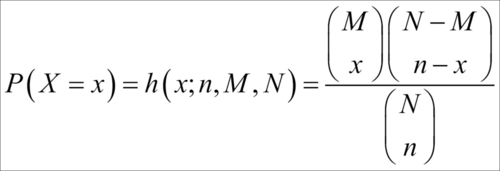
where x is an integer between  and
and  . The RV is called as the hypergeometric RV and its probability distribution is called as the hypergeometric distribution.
. The RV is called as the hypergeometric RV and its probability distribution is called as the hypergeometric distribution.
Suppose that we draw a sample of n = 10 units. The function dhyper in R can be used to find the probabilities of the RV X assuming different values.
> N <- 200; M <- 20 > n <- 10 > x <- 0:11 > round(dhyper(x,M,N,n),3) [1] 0.377 0.395 0.176 0.044 0.007 0.001 0.000 0.000 0.000 0.000 0.000 0.000
The mean and variance of a hypergeometric distribution are stated as follows:

Consider a variant of the problem described in the previous subsection. The 10 new desktops need to be fitted with an add-on, 5 megapixel external cameras to help the students attend a certain online course. Assume that the probability of a non-defective camera unit is p. As an administrator you keep on placing order until you receive 10 non-defective cameras. Now, let X denote the number of orders placed for obtaining the 10 good units. We denote the required number of success by k, which in this discussion has been k = 10. The goal in this unit is to obtain the probability distribution of X.
Suppose that the xth order placed results in the procurement of the kth non-defective unit. This implies that we have received (k-1) non-defective units among the first (x-1) orders placed, which is possible in  distinct ways. At the xth order, the instant of having received the kth non-defective unit, we have k successes and x-k failures. Hence, the probability distribution of the RV is calculated as:
distinct ways. At the xth order, the instant of having received the kth non-defective unit, we have k successes and x-k failures. Hence, the probability distribution of the RV is calculated as:

Such an RV is called the negative binomial RV and its probability distribution is the negative binomial distribution. Technically, this RV has no upper bound as the next required success may never turn up. We state the mean and variance of this distribution as follows:

A particular and important special case of the negative binomial RV occurs for k = 1, which is known as the geometric RV. In this case, the pmf is calculated as:

Example 1.3.3. (Baron (2007). Page 77) Sequential Testing: In a certain setup, the probability of an item being defective is (1-p) = 0.05. To complete the lab setup, 12 non-defective units are required. We need to compute the probability that at least 15 units need to be tested. Here we make use of the cumulative distribution of negative binomial distribution pnbinom function available in R. Similar to the pbinom function, the main arguments that we require here would be size, prob, and q. This problem is solved in a single line of code:
> 1-pnbinom(3,size=12,0.95) [1] 0.005467259
Note that we have specified 3 as the quantile point (the x argument) as the size parameter of this experiment is 12 and we are seeking at least 15 units which translate into 3 more units than the size parameter. The function pnbinom computes the cumulative distribution function and the requirement is actually the complement, and hence the expression in the code is 1–pnbinom. We may equivalently solve the problem using the dnbinom function, which straightforwardly computes the required probability:
> 1-(dnbinom(3,size=12,0.95)+dnbinom(2,size=12,0.95)+dnbinom(1, + size=12,0.95)+dnbinom(0,size=12,0.95)) [1] 0.005467259
The number of accidents on a 1 km stretch of road, total calls received during a one-hour slot on your mobile, the number of "likes" received on a status on a social networking site in a day, and similar other cases are some of the examples which are addressed by the Poisson RV. The probability distribution of a Poisson RV is calculated as:

Here  is the parameter of the Poisson RV with X denoting the number of events. The Poisson distribution is sometimes also referred to as the law of rare events. The mean and variance of the Poisson RV are surprisingly the same and equal
is the parameter of the Poisson RV with X denoting the number of events. The Poisson distribution is sometimes also referred to as the law of rare events. The mean and variance of the Poisson RV are surprisingly the same and equal  , that is,
, that is,  .
.
Example 1.3.4: Suppose that Santa commits errors in a software program with a mean of three errors per A4-size page. Santa's manager wants to know the probability of Santa committing 0, 5, and 20 errors per page. The R function dpois helps to determine the answer.
> dpois(0,lambda=3); dpois(5,lambda=3); dpois(20, lambda=3) [1] 0.04978707 [1] 0.1008188 [1] 7.135379e-11
Note that Santa's probability of committing 20 errors is almost 0.
We will next focus on continuous distributions.
The numeric variables in the survey, Age, Mileage, and Odometer, can take any values over a continuous interval and these are examples of continuous RVs. In the previous section we dealt with RVs which had discrete output. In this section we will deal with RVs which have continuous output. A distinction from the previous section needs to be pointed explicitly. In the case of a discrete RV, there is a positive number for the probability of an RV taking on a certain value which is determined by the pmf. In the continuous case, an RV necessarily assumes any specific value with zero probability. These technical issues will not be discussed in this book. In the discrete case, the probabilities of certain values are specified by the pmf, and in the continuous case the probabilities, over intervals, are decided by probability density function, abbreviated as pdf.
Suppose that we have a continuous RV, X, with the pdf f(x) defined over the possible x values, that is, we assume that the pdf f(x) is well defined over the range of the RV X, denoted by  . It is necessary that the integration of f(x) over the range
. It is necessary that the integration of f(x) over the range  is necessarily 1, that is,
is necessarily 1, that is,  . The probability that the RV X takes a value in an interval [a, b] is defined by:
. The probability that the RV X takes a value in an interval [a, b] is defined by:

In general we are interested in the cumulative probabilities of a continuous RV, which is the probability of the event P(X<x). In terms of the previous equations, this is obtained as:

A special name for this probability is the cumulative density function. The mean and variance of a continuous RV are then defined by:

As in the previous section, we will begin with the simpler RV in uniform distribution.
An RV is said to have uniform distribution over the interval  if its probability density function is given by:
if its probability density function is given by:

In fact, it is not necessary to restrict our focus on the positive real line. For any two real numbers a and b, from the real line, with b > a, the uniform RV can be defined by:

The uniform distribution has a very important role to play in simulation, as will be seen in Chapter 6, Linear Regression Analysis. As with the discrete counterpart, in the continuous case any two intervals of the same length will have equal probability of occurring. The mean and variance of a uniform RV over the interval [a, b] are respectively given by:

Example 1.4.1. Horgan's (2008), Example 15.3: The International Journal of Circuit Theory and Applications reported in 1990 that researchers at the University of California, Berkely, had designed a switched capacitor circuit for generating random signals whose trajectory is uniformly distributed over the unit interval [0, 1]. Suppose that we are interested in calculating the probability that the trajectory falls in the interval [0.35, 0.58]. Though the answer is straightforward, we will obtain it using the punif function:
> punif(0.58)-punif(0.35) [1] 0.23
The exponential distribution is probably one of the most important probability distributions in Statistics, and more so for Computer Scientists. The numbers of arrivals in a queuing system, the time between two incoming calls on a mobile, the lifetime of a laptop, and so on, are some of the important applications where this distribution has a lasting utility value. The pdf of an exponential RV is specified by  .
.
The parameter  is sometimes referred to as the failure rate. The exponential RV enjoys a special property called the memory-less property which conveys that :
is sometimes referred to as the failure rate. The exponential RV enjoys a special property called the memory-less property which conveys that :

This mathematical statement states that if X is an exponential RV, then its failure in the future depends on the present, and the past (age) of the RV does not matter. In simple words this means that the probability of failure is constant in time and does not depend on the age of the system. Let us obtain the plots of a few exponential distributions.
> par(mfrow=c(1,2))
> curve(dexp(x,1),0,10,ylab="f(x)",xlab="x",cex.axis=1.25)
> curve(dexp(x,0.2),add=TRUE,col=2)
> curve(dexp(x,0.5),add=TRUE,col=3)
> curve(dexp(x,0.7),add=TRUE,col=4)
> curve(dexp(x,0.85),add=TRUE,col=5)
> legend(6,1,paste("Rate = ",c(1,0.2,0.5,0.7,0.85)),col=1:5,pch=
+ "___")
> curve(dexp(x,50),0,0.5,ylab="f(x)",xlab="x")
> curve(dexp(x,10),add=TRUE,col=2)
> curve(dexp(x,20),add=TRUE,col=3)
> curve(dexp(x,30),add=TRUE,col=4)
> curve(dexp(x,40),add=TRUE,col=5)
> legend(0.3,50,paste("Rate = ",c(1,0.2,0.5,0.7,0.85)),col=1:5,pch=
+ "___")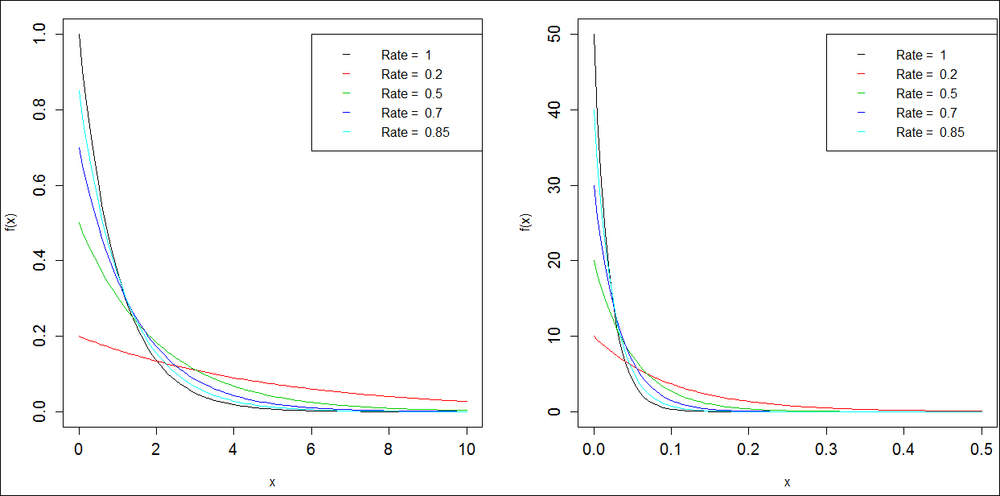
Figure 7: The exponential densities
The mean and variance of this exponential distribution are shown as follows:

The normal distribution is in some sense an all-pervasive distribution that arises sooner or later in almost any statistical discussion. In fact it is very likely that the reader may already be familiar with certain aspects of the normal distribution, for example, the shape of a normal distribution curve is bell-shaped. The mathematical appropriateness is probably reflected through the reason that though it has a simpler expression, and its density function includes the three most famous irrational numbers  .
.
Suppose that X is normally distributed with mean  and variance
and variance  . Then, the probability density function of the normal RV is given by:
. Then, the probability density function of the normal RV is given by:

If mean is zero and variance is one, the normal RV is referred as the standard normal RV, and the standard is to denote it by Z.
Example 1.4.2. Shady Normal Curves: We will again consider a standard normal random variable, which is more popularly denoted in Statistics by Z. Some of the most needed probabilities are P(Z > 0) and P(-1.96 < Z < 1.96). These probabilities are now shaded.
> par(mfrow=c(3,1)) > # Probability Z Greater than 0 > curve(dnorm(x,0,1),-4,4,xlab="z",ylab="f(z)") > z <- seq(0,4,0.02) > lines(z,dnorm(z),type="h",col="grey") > # 95% Coverage > curve(dnorm(x,0,1),-4,4,xlab="z",ylab="f(z)") > z <- seq(-1.96,1.96,0.001) > lines(z,dnorm(z),type="h",col="grey") > # 95% Coverage > curve(dnorm(x,0,1),-4,4,xlab="z",ylab="f(z)") > z <- seq(-2.58,2.58,0.001) > lines(z,dnorm(z),type="h",col="grey")
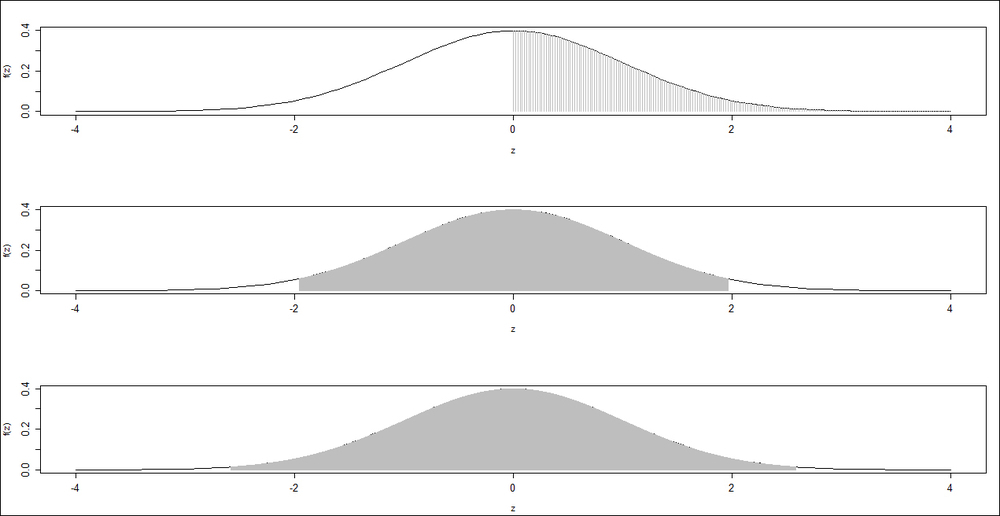
Figure 08: Shady normal curves
You should now be clear with the distinct nature of variables that arise in different scenarios. In R, you should be able to verify that the data is in the correct format. Further, the important families of random variables are introduced in this chapter, which should help you in dealing with them when they crop up in your experiments. Computation of simple probabilities were also introduced and explained.
In the next chapter you will learn how to perform the basic R computations, creating data objects, and so on. As data can seldom be constructed completely in R, we need to import data from external foreign files. The methods explained help you to import data in file formats such as .csv and .xls. Similar to importing, it is also important to be able to export data/output to other software. Finally, R session management will conclude the next chapter.





















